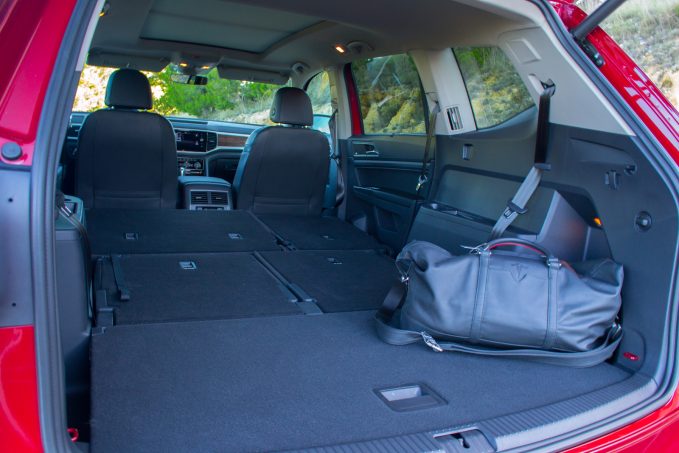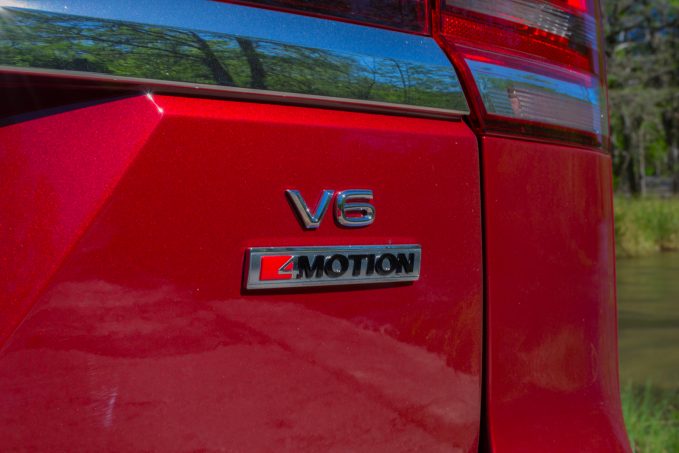It’s a bit of a stretch to say the 2018 Volkswagen Atlas is carrying the weight of the brand’s fortunes on its rather frumpy shoulders, though the reality isn’t far from what that name implies.
Whether chosen by coincidence or candor, the name of the Volkswagen’s latest and largest crossover is certainly fitting. The three-row Atlas represents the dawning of a new day for the brand, and, at least in North America, it’s one where diesel engines are no longer part of the equation. With Volkswagen looking to endear itself to the buying public through alternate means, the Atlas has suddenly been saddled with a rather large share of the responsibility in righting the ship on these shores.
Making the Atlas’ ascent of the sales charts even more challenging is the competition it’s up against. This midsize sport utility segment is one that’s long been dominated by the likes of the Ford Explorer, with mainstays like the Honda Pilot and Toyota Highlander posing further problems for new entries. That’s quite the gauntlet to walk — or rather drive — for any brand, let alone one with as much to prove as VW.
Made in America, Made for America
As Volkswagen’s new brand ambassador on this side of the Atlantic, the Atlas wasn’t simply modified for life here; it was made for it. According to Volkswagen, the Atlas is “built in America and designed for the American family.” You can, no doubt, lump Canadian families into that self-aggrandizement, too. As such, the North America-centric sport utility is built alongside the North American version of the Passat midsize sedan in Chattanooga, Tennessee, with its sights set squarely on the segment’s best.
Stretching 198.3 inches (5,036 millimeters) from bumper to bumper, the Atlas is Volkswagen’s largest vehicle by a large margin. In fact, the Atlas is the brand’s biggest since the Routan, a rebadged version of the Dodge Grand Caravan that was last produced more than three years ago. It’s nearly 10 inches (254 mm) longer than the Touareg, allowing it to easily accommodate a third row of seats while looking every bit as bullish as the segment-leading Explorer.
ALSO SEE: 2018 Chevrolet Equinox Review
As powerful as the Atlas may appear, its exterior aesthetic is far from exciting. At a time when design is becoming as daring as it’s been in years — look no further than the 2018 Toyota C-HR for proof — the Atlas is downright dull. It’s square and plain, with little more than an exaggerated character line that runs tip to tail adding a splash of personality to the Atlas’ outward appearance. Styling is, of course, subjective, but this brutish ute looks somewhat dated right out of the gate, a clear sign that Volkswagen played it too safe with the design.
The cabin is equally uninspired, though it’s far easier to play off the muted aesthetic as simplistic and modern. Whether decked out in cloth, leatherette or leather upholstery, the cabin is bland but not necessarily cheap, and is best described as being slightly utilitarian in execution. Heavy doses of plastic are found throughout, right down to the “wood appearance” accents in upper trim grades that are of the thermoplastic variety. Even the interior’s showpieces, namely the eight-inch touchscreen on the center stack, are presented with few frills. Further prioritizing function over form, clean lines lead to all kinds of cubbies and cupholders scattered throughout the interior.
Tons of Space Inside
But the cabin of the Volkswagen Atlas is made for more than just storing stuff, and is well suited to moving people, too. Lots of them, in fact. A purebred three-row through and through, the Atlas is available in six- and seven-passenger configurations, depending on trim and options. Regardless, the cavernous space inside will leave few feeling cramped in almost any seating position.
The Atlas’ generous overall length combines with its wheelbase that measures an impressive 117.3 inches (2,979 mm) to prioritize passengers, providing ample room to stretch out. Space in the second row is listed at 37.6 inches (955 mm) of legroom though it feels like much more. With the driver’s seat adjusted to accommodate my 6-foot-4 frame, there was enough room for me to sit comfortably in the second row on our drive outside San Antonio, Texas. The second row also boasts 60.8 inches (1,544 mm) of shoulder room, which is plenty; enough, in fact, to strap three car seats in side by side.
Not to be outdone by the likes of the Explorer, the Atlas proffers slightly more legroom in the third row, with a maximum of 33.7 inches (856 mm). For those in need of more — or less — space in the back, the second-row seats can slide forward as much as 7.7 inches (196 mm). Better still, the third row can be accessed by tumbling either second-row outboard seat forward — something that can be done with a car seat attached.
ALSO SEE: 2017 Hyundai Santa Fe Limited Ultimate AWD Review
Accessing either row of rear seats is also done with ease thanks to doors that open almost 90 degrees, which is a parent’s best friend when it comes time to strap the kids in their seats. What’s more, the door openings are wide, and sacrifice very little space to the rear wheel wells, a benefit of the Atlas’ long wheelbase. But best of all, both rear rows are actually useable. Outside of seats that proved a little rigid and upright, the Atlas hits the mark when it comes to family-friendly confines.
The cargo capacity situation is a familiar one for any three-row SUV. With all three rows upright, space for stuff shrinks to an awkwardly upright 20.6 cu-ft (583 liters), or slightly less than what’s available in a compact hatchback. Space behind the second row is significantly more generous, with 55.5 cu-ft (1,572 liters) on offer, which is far more than the 43.9 cu-ft (1,243 liters) than what’s in the Explorer. Finally, folding both rear rows results in 96.8 cu-ft (2,741 liters) of room. That’s significantly more than the Explorer’s 81.7 cu-ft (2,313 liters), and is a testament to just how cavernous the Atlas’ cabin really is.
Short on Power, Big on Comfort
Motivating the Atlas’ size, not to mention all the stuff that can fit inside, is the choice of two engines mated to an eight-speed automatic transmission. With the base engine, a turbocharged four-cylinder, not set to go on sale until later in the year, the upgraded 3.6-liter V6 was the only one available for our test in Texas.
The six-cylinder makes 276 horsepower and 266 lb-ft of torque, which is slightly unimpressive both on paper and in practice. The engine proved to be pretty gutless during our drive, feeling sluggish under acceleration. It’s also not much of a fuel miser, with our all-wheel drive tester netting something in the neighborhood of its combined rating of 18 mpg (13.7 L/100 km) during our 140-mile (225-kilometer) drive.
When it comes to ride quality, the Atlas is second to none in the segment. The multi-link suspension setup possesses an almost air-like quality, and uses the Atlas’ mass — the curb weight is listed at a pudgy 4,221 lb (1,915 kg) — to smooth the road beneath it. The dampers’ rebound rates could use some work, and are a little bouncy at times, but the ride is as smooth if not smoother than anything in the segment. It was only the cabin quietness test that the Atlas failed, with Texas’ notoriously porous pavement pouring an awful lot of road noise inside.
Price and Packaging
It’s not quite right to say the Atlas’ pricing is a make-good project, but it’s pretty close. If there was a nit to pick with the Volkswagen Touareg it would be rooted in its price. While its equipment and overall feel has long bordered on premium quality, so too has the Touareg’s pricing. Base models start at a whopping $49,495 ($51,960 in Canada), which is slightly more than an entry-level 2017 Audi Q7. (Canadian Q7s, meanwhile, feature a different spec sheet, and start at $61,900.) That has long left a massive hole in the brand’s lineup, one that fans have been forced to fill elsewhere. Volkswagen has righted that wrong with the Atlas.
A base V6 version starts at $34,990 ($39,790 in Canada), which is far easier to digest than the price of a Touareg. For that kind of scratch, the Atlas features a long list of standard equipment, including 18-inch alloy wheels, a rearview camera, and Apple CarPlay and Android Auto compatibility. (Base V6 versions in Canada come with all-wheel drive as standard equipment, but make do with a slightly smaller 6.5-inch touchscreen on the center stack.)
ALSO SEE: 2017 Mazda CX-5 Review
Top-of-the-line models, meanwhile, start at $48,490 ($52,540 in Canada) and get a ton of additional features, heated and ventilated seats up front and heated second-row seats, a 12-speaker audio system that works wonders in drowning out road noise, and Volkswagen’s Digital Cockpit display. Similar to Audi’s Virtual Cockpit, the system from Volkswagen replaces the Atlas’ gauge cluster with a digital unit that can put information like maps directly in front of the driver. The system isn’t quite as robust as Audi’s, and can be slightly more frustrating at times — it can’t, for example, display maps on both cluster and infotainment screens at once — but it’s definitely helpful in putting relevant info in front of the driver.
Other features offered on the Atlas include a handy self-parking system that will do the job in parallel and forward and reverse perpendicular fashions, as well as the usual gambit of active safety systems, including adaptive cruise control. Unfortunately, our test offered no opportunities to try the adaptive cruise system on the desolate back roads outside San Antonio, though the systems in the brand’s other offerings have worked as advertised.
The Verdict: 2018 Volkswagen Atlas V6 Review
Considering how much it means for the brand, the 2018 Volkswagen Atlas looks like a bit of a dud. Looks can, however, be deceiving, and what it lacks in aesthetic appeal it more than makes up for in its ability to provide a family-friendly ride that’s focused on all the right stuff. It’s also priced right, and can easily go toe-to-toe with the segment’s best.











